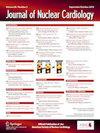如何执行和解释心脏淀粉样变性放射性核素成像(CARI)。
IF 2.7
4区 医学
Q2 CARDIAC & CARDIOVASCULAR SYSTEMS
引用次数: 0
摘要
心脏淀粉样变性放射性核素成像(CARI)已经改变了疑似甲状腺素型心肌病(atr - cm)的诊断方法,使非侵入性诊断成为可能,并减少了活检的需要。本文以一个临床病例为例,对CARI的实施和解释提供了实用的指导。排除单克隆γ病是保持特异性的必要条件。如果没有,单光子发射计算机断层扫描(SPECT)可以诊断Perugini 2-3级摄取;单纯平面成像或心脏与对侧比值是不够的。最佳做法包括有效的示踪剂(99mTc-DPD, - pyp, - hmdp),正确的时间避免血池活动,SPECT -最好与CT -准确定位。解释应考虑诸如非弥漫性摄取、伪影和其他原因(如AL淀粉样变性、梗死、药物毒性)等缺陷。新兴的应用包括定量SPECT/CT的分期、预后和治疗监测,尽管需要标准化。坚持专家共识和技术标准,最大限度地提高了CARI诊断的准确性和安全整合到心脏淀粉样变的管理。本文章由计算机程序翻译,如有差异,请以英文原文为准。
How to perform and interpret cardiac amyloidosis radionuclide imaging (CARI)
Cardiac amyloidosis radionuclide imaging (CARI) has transformed the diagnostic approach to suspected transthyretin cardiomyopathy (ATTR-CM), enabling non-invasive diagnosis and reducing the need for biopsy. This review provides practical guidance for performing and interpreting CARI, illustrated by a clinical case. Exclusion of monoclonal gammopathy is essential to preserve specificity. When absent, Perugini grade 2–3 uptake on single-photon emission computed tomography (SPECT) is diagnostic; planar imaging or heart-to-contralateral ratios alone are insufficient. Optimal practice includes validated tracers (99mTc-DPD, -PYP, -HMDP), correct timing to avoid blood pool activity, and SPECT - preferably with CT - for accurate localization. Interpretation should account for pitfalls such as non-diffuse uptake, artifacts, and alternative causes (e.g., AL amyloidosis, infarction, drug toxicity). Emerging applications include quantitative SPECT/CT for staging, prognosis, and therapy monitoring, though standardization is needed. Adherence to expert consensus and technical standards maximizes diagnostic accuracy and safe integration of CARI into the management of cardiac amyloidosis.
求助全文
通过发布文献求助,成功后即可免费获取论文全文。
去求助
来源期刊
CiteScore
5.30
自引率
20.80%
发文量
249
审稿时长
4-8 weeks
期刊介绍:
Journal of Nuclear Cardiology is the only journal in the world devoted to this dynamic and growing subspecialty. Physicians and technologists value the Journal not only for its peer-reviewed articles, but also for its timely discussions about the current and future role of nuclear cardiology. Original articles address all aspects of nuclear cardiology, including interpretation, diagnosis, imaging equipment, and use of radiopharmaceuticals. As the official publication of the American Society of Nuclear Cardiology, the Journal also brings readers the latest information emerging from the Society''s task forces and publishes guidelines and position papers as they are adopted.

 求助内容:
求助内容: 应助结果提醒方式:
应助结果提醒方式:


